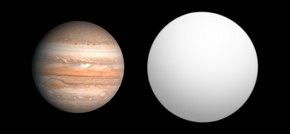 Size comparison of OGLE-TR-56b with Jupiter. Size comparison of OGLE-TR-56b with Jupiter. | |
| Discovery | |
|---|---|
| Discovered by | Dimitar D. Sasselov et al. |
| Discovery date | 3 November 2002 confirmed: 4 January 2003 |
| Detection method | Transit |
| Orbital characteristics | |
| Apastron | 0.0225 AU (3,370,000 km) |
| Periastron | 0.0225 AU (3,370,000 km) |
| Semi-major axis | 0.0225 ± 0.0004 AU (3,366,000 ± 60,000 km) |
| Eccentricity | 0 |
| Orbital period (sidereal) | 1.211909 ± 0.000001 d 29.08582 h |
| Average orbital speed | 203 |
| Inclination | 78.8 ± 0.5 |
| Star | OGLE-TR-56 |
| Physical characteristics | |
| Mean radius | 1.30 ± 0.05 RJ |
| Mass | 1.29 ± 0.12 MJ |
| Mean density | 0.779 g/cm |
| Surface gravity | 19.8 m/s (65 ft/s) 2.02 g |
| Temperature | ~1973 |
OGLE-TR-56b is an extrasolar planet located approximately 1500 parsecs or 5000 light years away in the constellation of Sagittarius, orbiting the star OGLE-TR-56. This planet was the first known exoplanet to be discovered with the transit method. The object was discovered by the OGLE project, announced on July 5, 2002 and confirmed on January 4, 2003 by the Doppler technique. The period of this confirmed planet was the shortest until the confirmed discovery of WASP-12b on April 1, 2008. The short period and proximity of the OGLE-TR-56 b to its host mean it belongs to a class of objects known as hot Jupiters.

The planet is thought to be only 4 stellar radii from its star, and hot enough to have iron rain.
See also
References
- Konacki, Maciej; et al. (2003). "An extrasolar planet that transits the disk of its parent star" (PDF). Nature. 421 (6922): 507–509. Bibcode:2003Natur.421..507K. doi:10.1038/nature01379. PMID 12556885. S2CID 1784939.
- Udalski, A.; et al. (2002). "The Optical Gravitational Lensing Experiment. Search for Planetary and Low-Luminosity Object Transits in the Galactic Disk. Results of 2001 Campaign - Supplement". Acta Astronomica. 52 (2): 115–128. arXiv:astro-ph/0207133. Bibcode:2002AcA....52..115U.
- Konacki, Maciej; et al. (2003). "High-Resolution Spectroscopic Follow-up of OGLE Planetary Transit Candidates in the Galactic Bulge: Two Possible Jupiter-Mass Planets and Two Blends". The Astrophysical Journal. 597 (2): 1076–1091. arXiv:astro-ph/0306542. Bibcode:2003ApJ...597.1076K. doi:10.1086/378561. S2CID 53610157.
- Hebb, L.; et al. (2009). "WASP-12b: THE HOTTEST TRANSITING EXTRASOLAR PLANET YET DISCOVERED". The Astrophysical Journal. 693 (2): 1920–1928. arXiv:0812.3240. Bibcode:2009ApJ...693.1920H. doi:10.1088/0004-637X/693/2/1920. S2CID 14526064.
- Harvard University and Smithsonian Institution (2003-01-08). "New World of Iron Rain". Astrobiology Magazine. Archived from the original on 2010-01-10. Retrieved 2010-01-25.
External links
![]() Media related to OGLE-TR-56 b at Wikimedia Commons
Media related to OGLE-TR-56 b at Wikimedia Commons
- "OGLE-TR-56 b". Exoplanets. Archived from the original on 2007-12-03. Retrieved 2010-01-21.
This extrasolar-planet-related article is a stub. You can help Misplaced Pages by expanding it. |